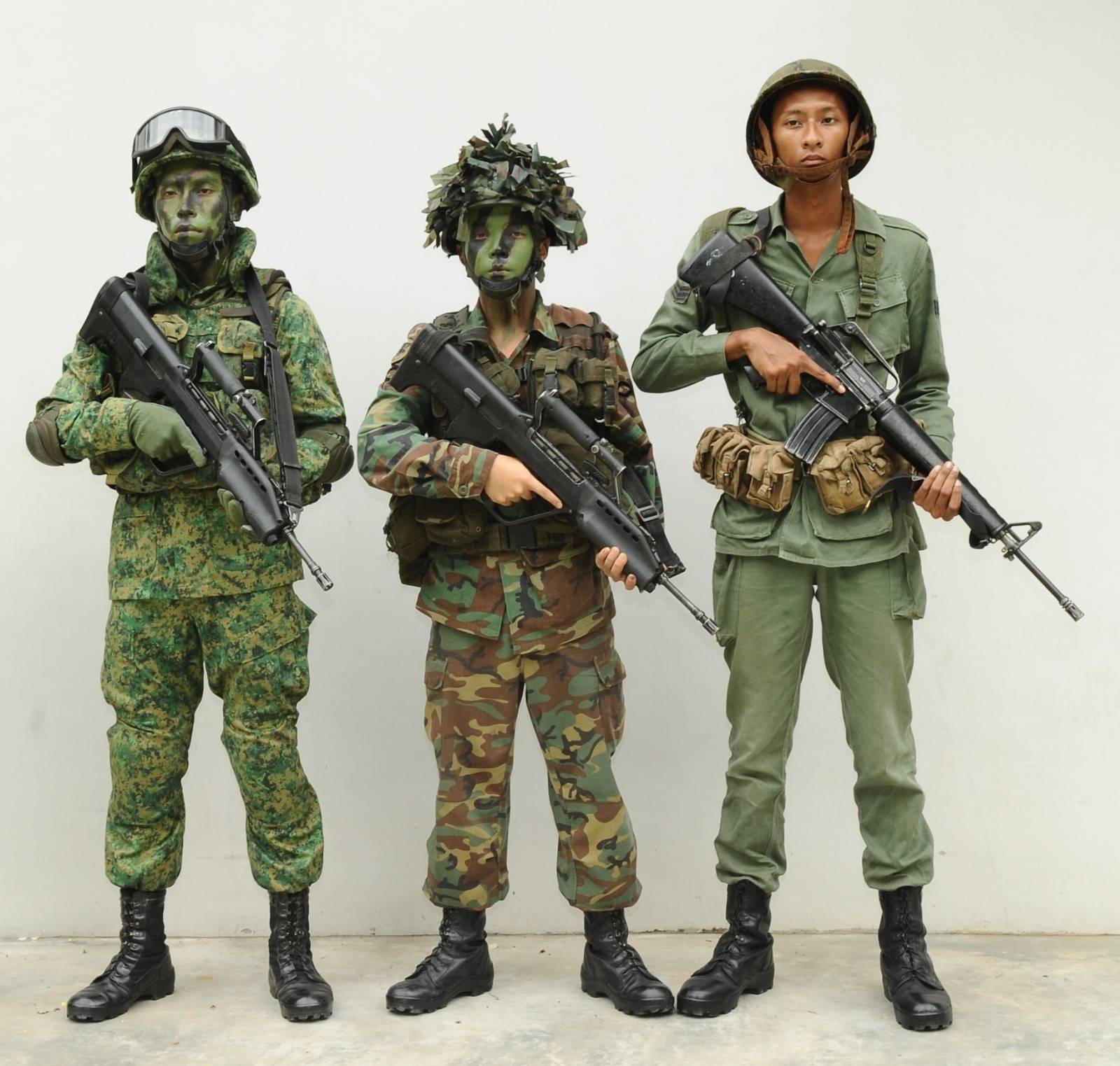SINGAPORE: Army combat soldiers are now being issued with a new hybrid uniform that is more comfortable and dissipates heat faster.
The new uniform is made up of the usual Number 4 uniform pixelated fabric and a high-performance fabric, which comprises a combination of flame resistant synthetic materials and aramid, a type of fibre that is strong and heat-resistant.
It is designed to be worn under the integrated load bearing vest during combat exercises and outfield activities. Soldiers will still be required to wear the Number 4 uniform for other routine activities.
“What this means is that when our soldiers wear the load bearing vest, they will sustain better and endure longer in a combat environment,” head of the Centre of Excellence for Soldier Performance (CESP) Senior Lieutenant Colonel Yee Kok Meng said on Tuesday (Jun 19).
The new uniform was unveiled as Chief of Defence Force Major-General Melvyn Ong said the Singapore Armed Forces (SAF) was committed to equipping its solders with better equipment, like a new load bearing vest that dissipates heat better.
“All these we are doing to support the individual, and the CESP will also, especially in the area of heat injuries, get behind it,” he added.
FEATURES
The hybrid uniform’s high-performance fabric has a porous construction that allows for better air circulation, meaning it is 1.4 times as permeable as the Number 4 uniform. It also absorbs perspiration quickly and is 1.6 times as effective in drying.
The fabric is also fire-resistant and comes with “self-extinguishing abilities”. “Hence, it does not melt or drip when exposed to extreme heat,” the Ministry of Defence (MINDEF) said.
The new uniform began rolling out in January to soldiers from the Army combat units, chosen for their physically-demanding missions, with equipping to be completed by the end of this year. Each soldier will receive two pieces of the uniform.
Infantry units like 3rd and 6th Battalion, Singapore Infantry Regiment (SIR) have been fully equipped with the uniform.
Infantry soldiers doing lunges in the new uniform. (Photo: MINDEF)
Full-time national serviceman Private (PTE) Kugan Senivasan, a 4 SIR trooper, said he feels a “genuine difference” wearing the hybrid uniform during strenuous training.
“When you’re doing exercises, the Number 4 uniform drags on your body a lot, whereas this is rather smooth and comfortable,” the 18-year-old said.
The uniform will also come in handy during outfield exercises, when soldiers have “sweat and camouflage dripping down” their faces, PTE Kugan added.
4 SIR soldiers wearing the hybrid uniform during their vocation fitness training. (Photo: Aqil Haziq Mahmud)
However, MINDEF said there are no plans to distribute the new uniform to operationally-ready national servicemen during In-Camp Training as the Number 4 uniform still meets their training requirements.
“Servicemen will be able to replace their hybrid uniform at eMart outlets via credit or cash,” MINDEF said. “Stock is still being built up progressively for retail at eMart outlets.”
A HISTORY OF UNIFORMS
The hybrid uniform was conceptualised in 2011 for the Army and has undergone “extensive” trials, with input from agencies like the Defence Science Technology Agency (DSTA) and ST Logistics, MINDEF said.
“Various agencies worked together in the acquisition process, from crafting of technical specification to ensuring the quality of the final product fulfills our requirements,” it added.
From left, the current pixelated uniform, the older camouflage design and the Temasek Green uniform. (Photo: Singapore Ministry of Defence)
The last major change to the Army Number 4 uniform took place in 2008, when the current pixelated design replaced its more jungle-oriented, camouflage predecessor.
Back then, a need to optimise the performance of 3rd Generation SAF soldiers in both urban and forested terrains had emerged.
The current uniform has better camouflaging capabilities. (Photo: Singapore Ministry of Defence)
Extensive DSTA research had revealed that the new pixelised pattern helps to generate a “quivering” effect that reduces the eye’s ability to discern recognisable shapes, defence magazine CyberPioneer reported.
“It’s safe to say we’re looking at a 30 to 50 per cent enhancement in the soldier’s camouflage capability,” then-Chief of Staff, HQ 9 Division/Infantry, Colonel Tan Chor Kiat had said.
Besides the new design and features like frontal epaulettes, the pixelated uniform also enabled better air flow and heat dissipation, drying two times faster than the old uniform.
CAMOUFLAGE AND TEMASEK GREEN
Moving further back in time, the old camouflage design, influenced by the American-developed camouflage cloth, was introduced in 1983.
“With the continuing Rambo series keeping the camo look in the forefront, the uniform became so fashionable that the SAF had to remind fashionistas that to wear it casually was an offence under the Decorations and Uniforms Act,” one Hayden Ng wrote in a MINDEF article commemorating SAF50.

The current uniform was introduced in 2008, 25 years after the camouflage design debuted. (Photo: Singapore Ministry of Defence)
Its predecessor, the first generation Temasek Green SAF combat uniform, debuted for the Army, Navy and Air Force in 1967.
“Made of thick cotton, the shirt had to be tucked in,” Mr Ng wrote. “And although it was fashionably slim cut for the sixties, it was not particularly practical to serve double duty as a parade uniform and for field training.”




